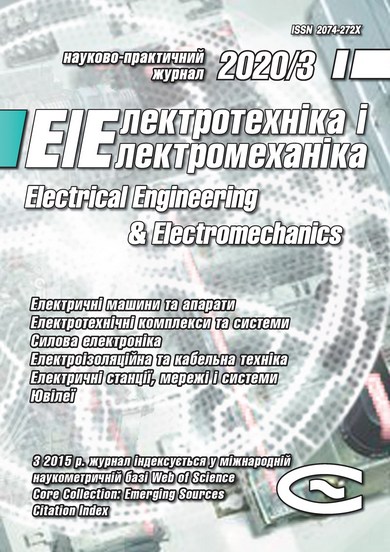MODELLING OF OPERATION MODES AND ELECTROMAGNETIC INTERFERENCES OF GaN-TRANSISTOR CONVERTERS
DOI:
https://doi.org/10.20998/2074-272X.2020.3.06Keywords:
GaN transistors, computer simulation, electromagnetics interferences, energy efficiencyAbstract
Goal. To analyze the efficiency and EMI of a half-bridge converter built on GaN transistors at different switching frequencies and to issue recommendations for its application. Methodology. An EPC9035 development board from Efficient Power Conversion was selected for research. This board is a half-bridge converter built on the EPC2022 eGaN® transistors and contains a driver for controlling these transistors. To simplify the assessment of the conversion efficiency, it is suggested to use a computer model of the development board and LISN, which simulates the active load with the LC filter. Results. Simulation results of the converter efficiency with the nominal values of the elements according to the EPC9035 manual showed significant deviations from the calculated values at frequencies above 50 kHz. This is explained by the presence of inrush current through transistors. The inrush current depends on the «dead time» between the intervals when the transistors are open and the delays specified in the SPICE model of LM5113 driver. To reduce the amplitude of inrush current and, accordingly, to increase the duration of the «dead time» interval, it is proposed to double the capacitors responsible for the formation of this interval. Simulation of the converter efficiency with the doubled values of the circuit elements showed that the results almost coincide with the calculated values of the efficiency in the range from 0.05 MHz to 5 MHz. The converter on the EPC2022 transistors has the highest efficiency at 50 kHz which decreases by 0.03-0.04 at 500 kHz. Therefore, it is recommended that the operating frequency should be set close to 500 kHz. Simulation of EMI levels resulted that the difference in the duration of the «dead time» does not have a significant effect on the levels of simulated EMI. The largest difference between the simulation results and the experiment is observed at frequencies about 30 MHz and is 3-6 dB. Originality. For the first time, the computer model was used to calculate the efficiency of a half-bridge converter on GaN transistors at different frequencies. Practical significance. Considering the high output current, high operating voltage and short switching times, GaN transistors are promising for use in pulse generators, power supplies with operating frequencies exceeding 500 kHz, and in powerful Class D hi-fi amplifiers with small dimensions, such as automotive ones.References
Tüysüz A., Bosshard R. Kolar J.W. Performance comparison of a GaN GIT and a Si IGBT for high-speed drive applications. 2014 International Power Electronics Conference (IPEC-Hiroshima 2014 – ECCE ASIA), Hiroshima, 2014, pp. 1904-1911. doi: 10.1109/IPEC.2014.6869845.
Lee D., Soh M.Y., Teo T.H., Yeo K.S. Evaluation of Low Voltage Rectifier Design Using IGBT, MOSFET, and GaN FETs. TENCON 2018 – 2018 IEEE Region 10 Conference, Jeju, Korea (South), 2018, pp. 0389-0393. doi: 10.1109/TENCON.2018.8650321.
Biela J., Schweizer M., Waffler S., Kolar J.W. SiC versus Si–Evaluation of Potentials for Performance Improvement of Inverter and DC–DC Converter Systems by SiC Power Semiconductors. IEEE Transactions on Industrial Electronics, 2011, vol. 58, no. 7, pp. 2872-2882. doi: 10.1109/TIE.2010.2072896.
Han D., Li S., Lee W., Choi W., Sarlioglu B. Trade-off between switching loss and common mode EMI generation of GaN devices-analysis and solution. 2017 IEEE Applied Power Electronics Conference and Exposition (APEC), Tampa, FL, 2017, pp. 843-847. doi: 10.1109/apec.2017.7930794.
Liu X., Costa F., Revol B., Gautier C. EMI investigation in a GaN HEMT power module. PCIM Europe 2016; International Exhibition and Conference for Power Electronics, Intelligent Motion, Renewable Energy and Energy Management,Nuremberg,Germany, 2016, pp. 1-8.
Gedz O., Lazebnyi V., Onikienko Y., Vlasjuk A. EMI simulation of GaN power stage for audio class D amplifiers. 2018 14th International Conference on Advanced Trends in Radioelecrtronics, Telecommunications and Computer Engineering (TCSET), Slavske, 2018, pp. 204-207. doi: 10.1109/TCSET.2018.8336187.
Lidow A., Strydom J., de Rooij M., Reusch D., Glaser J. GaN Transistors for Efficient Power Conversion, Third Edition. New York, John Wiley & Sons, 2020. doi: 10.1002/9781119594406.
Ibuchi T., Funaki T. A comparative study on conducted noise characteristics of SiC and GaN power transistor. 2016 International Symposium on Electromagnetic Compatibility – EMC EUROPE, Wroclaw, 2016, pp. 193-198. doi: 10.1109/emceurope.2016.7739169.
Onikienko Y., Pilinsky V., Rodionova M. Conductive EMI of class D audio amplifiers prediction system. 2015 IEEE 35th International Conference on Electronics and Nanotechnology (ELNANO), Kiev, 2015, pp. 437-440. doi: 10.1109/elnano.2015.7146925.
Onikienko Y., Vlasyuk A., Marchenko O., Popovych P., Filipova N., Shevchenko I. High Frequency Half-Bridge GaN-Based Pulse Generator. 2019 IEEE 39th International Conference on Electronics and Nanotechnology (ELNANO), Kyiv, Ukraine, 2019, pp. 700-703. doi: 10.1109/elnano.2019.8783532.
Downloads
Published
How to Cite
Issue
Section
License
Copyright (c) 2020 Y. O. Onikienko, V. V. Pilinsky, P. V. Popovych, V. S. Lazebnyi, O. I. Smolenska, V. S. Baran

This work is licensed under a Creative Commons Attribution-NonCommercial 4.0 International License.
Authors who publish with this journal agree to the following terms:
1. Authors retain copyright and grant the journal right of first publication with the work simultaneously licensed under a Creative Commons Attribution License that allows others to share the work with an acknowledgement of the work's authorship and initial publication in this journal.
2. Authors are able to enter into separate, additional contractual arrangements for the non-exclusive distribution of the journal's published version of the work (e.g., post it to an institutional repository or publish it in a book), with an acknowledgement of its initial publication in this journal.
3. Authors are permitted and encouraged to post their work online (e.g., in institutional repositories or on their website) prior to and during the submission process, as it can lead to productive exchanges, as well as earlier and greater citation of published work.





